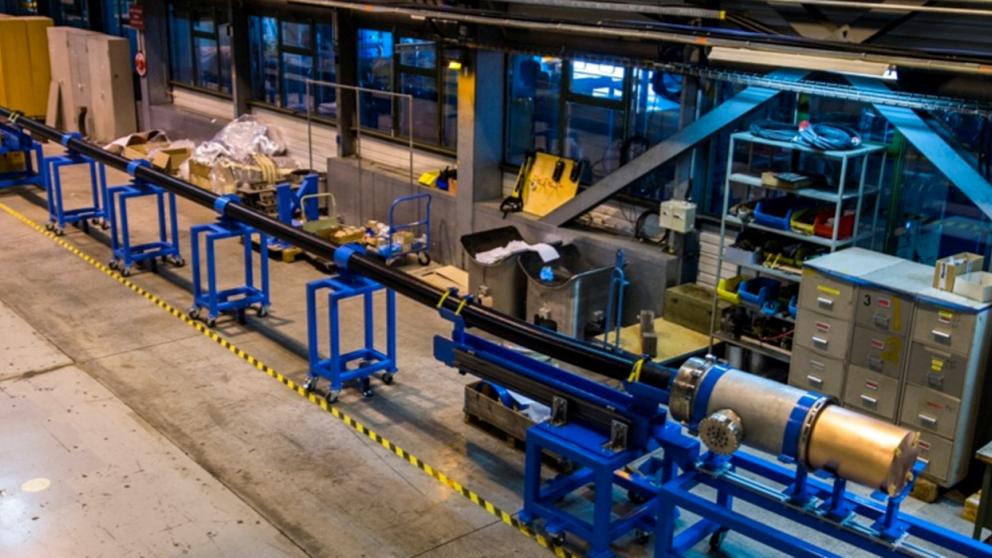Long-distance transport of green power: First successful testing of a 20 kA superconducting cable
11.03.2014
The growing deployment of renewable energy sources (RES) will have to be accompanied by a significant expansion of the electricity grids. The places where the generation of energy from wind, solar or hydro would be most economically competitive are often located in remote areas (offshore wind for example), distant from the densely populated zones where the energy is needed. Furthermore, grid extensions increase the system’s flexibility, thereby facilitating the integration of rising shares of variable RES. Consequently, the construction of new and efficient long-distance electricity transport infrastructure has become a strategic priority for all countries seeking to increase the share of green power in their energy mix. In this perspective, the Institute for Advanced Sustainability Studies (IASS) together with CERN (European European Organization for Nuclear Research) is investigating an innovative technological option based on the use of superconductivity as an alternative to standard HVDC (High Voltage Direct Current) power lines. This research programme reached an important milestone on February 20th with the successful testing of a prototype superconducting cable able to carry 20 kA of current.

Nobel Laureate and IASS Scientific Director Carlo Rubbia commented on this result: “This is really a breakthrough. For the first time, we have a real cable which offers a practical way of transporting large amounts electricity over long distances, using a simple configuration and cheap, widely available materials”. The experiment, which was the first of its kind, took place in the laboratories of CERN in the framework of an IASS-CERN collaboration aimed at assessing the potential of electric power cables based on the superconducting material magnesium diboride (MgB2). The tested configuration consists of two very thin, 20 m-long MgB2 cables combined in series for direct current (DC) transmission, and placed inside a semi-flexible cryostat that uses helium gas to maintain the very low temperatures required to enable superconductivity. During this latest test, the cable setup, which has a total diameter of only 16 cm, housed two MgB2 cables able to transfer a current of 20 kA at low temperatures of about 24 K, and showed very good and homogeneous superconducting properties.
In the future, this type of superconducting cable could be installed underground, with periodically spaced cryogenic stations; a technology that is similar to the widespread natural gas distribution grid. It would achieve capacities of 2 to 10 GW, or even higher, with operating voltages that can be tailored for optimised performance. To give an example, the planned German Suedlink transmission line, meant to connect the North Sea to Lower Franconia, would have a capacity of 4 GW with a subsequent uprating to 12 GW by 2032 (Netzentwicklungsplan).
In comparison to the alternatives, these superconducting underground cables would provide several significant advantages ranging from efficiency, cost, ease of implementation and environmental impact. First of all, superconducting materials like MgB2 are able to transmit electrical power without incurring resistive losses, which on the contrary affect conventional HVDC (and AC) lines and increase with the length of the line. Fewer losses translate into increased economic profitability and better resource management, as less energy is wasted.
Another distinctive feature of MgB2 SC cables is their small size: the whole installation for a 4 GW 800 km-long bi-polar cable, including the cryogenic envelope, is expected to have a total diameter of about 30 cm, which is less than most existing natural gas pipelines and much smaller than the corridor width needed for standard HVDC underground cables (about 20 m for 10 GW in central Europe). These latter also suffer from heat dispersion issues that severely limit the maximum capacity and have negative consequences for soils; in the case of SC cables, this drawback is entirely eliminated.
Finally, the choice of underground cables instead of overhead lines carries the usual benefits: it enables underwater crossings and transmission within densely populated areas and avoids the need to build massive transmission towers. Public opposition to invasive and environmentally harmful overhead lines has become an important factor in the decision-making process regarding grid expansion projects. Therefore, the search for technological alternatives is paramount. Additionally, existing rights-of-way could be used to install SC cables.
The first cost estimates show that the investment costs for the construction of a 4 GW MgB2 transmission line would be up to several times lower than for a standard ±320 kV HVDC underground cable, and competitive with HVDC overhead lines. The relatively low cost of MgB2 SC cables stems from their low cost per kA and meter (due to inexpensive materials) and simple manufacturing process.
Presently, IASS and CERN are pioneering the development of MgB2 cables. The results of the recent test have confirmed the promising nature of magnesium diboride, especially with respect to alternative materials like the expensive high-temperature superconductors (HTS). Additional tests of the prototype cable are planned in the coming weeks with the purpose of conducting further measurements and experimenting under various conditions. In parallel to these experimental activities, IASS has established contacts with partners from European industries and transmission operators in order to undertake the next steps in the R&D process and move towards industrial application.